Najad 332
A turbocharged midsized cruiser is just what the doctor ordered
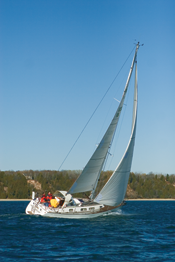 What do you do if, after sailing small sport boats for many years, you have an urge for a more robust cruising boat but don't want to give up the performance you have come to love? Well, you take a proven conservative cruising boat and you "turbo" it.
What do you do if, after sailing small sport boats for many years, you have an urge for a more robust cruising boat but don't want to give up the performance you have come to love? Well, you take a proven conservative cruising boat and you "turbo" it.Dr. Michael Leland of Valparaiso, Indiana, did just that with a Najad 332. Leland selected the Najad 332 for its quality, comfort and seakeeping abilities, but while the 332 is no slouch it won't be the first boat across the finish line. To get the performance he desired, Leland worked with Najad to up the performance ante, by adding a taller carbon fiber rig, and a deck-mounted retractable carbon fiber bowsprit.
I had a chance to sail Leland's boat Hope in SAILING Magazine's home port of Port Washington, Wisconsin. We had a perfect cool, crisp late fall day, with a steady land breeze and miles of flat Lake Michigan water all to ourselves.
The details
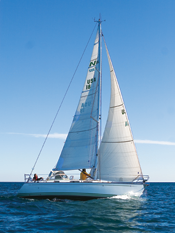 The clean hull lines are the work of the German/Dutch design firm Judel/Vrolijk & Co., and the balance of the design is done in-house at Najad. The boats are built in Henan on the island of Orust, off of Sweden's western coast. Najad has been building boats here since 1971.
The clean hull lines are the work of the German/Dutch design firm Judel/Vrolijk & Co., and the balance of the design is done in-house at Najad. The boats are built in Henan on the island of Orust, off of Sweden's western coast. Najad has been building boats here since 1971.
Najad builds all of its boats to withstand the rigors of offshore sailing, and the 332 is no exception. The hull and deck are heavily laid up, with a foam core providing sound and thermal insulation. The boat is built with good old-fashioned tabbed-in structural bulkheads-this construction technique, while far more labor intensive, makes for a stronger hull structure. Once the hull and deck are married the joint is glassed over, assuring a stiff, solid joint and one free from leaks.
The lead external keel is bolted onto an angled fiberglass keel stub. With a typical bolt-on keel, a hard grounding will tend to separate the keel from the hull on the leading edge, and force the keel up into the hull on the trailing edge, the angled stub more efficiently and evenly transfers the grounding loads to the hull. The deep stub also provides for a nice deep bilge sump, an asset on any boat.
I was impressed with the access to the mechanicals. The companionway stairs remove, giving easy access to the engine for routine maintenance, and all of the mechanical systems are similarly accessible, it is clear that Najad carefully planned out all of the installations. The electrical panel was nicely organized and the wiring very tidy.
As I mentioned this boat was upgraded with a full carbon rig from GMT Composites. The deck-stepped rig is fractional with aft swept spreaders, solid rod rigging, and a hydraulic backstay adjuster. The boat also has an optional retractable carbon fiber bowsprit. The sprit mounts very cleanly on the foredeck, with an easy-to-use track system for deployment.
The 332 holds 37 gallons of water and 20 gallons of diesel in stainless steel tanks. This tankage is sufficient for coastal cruising, but would need to be augmented with some on-deck jerry cans for extended passages. The galley sink has a seawater foot pump to help stretch the freshwater supplies.
On deck
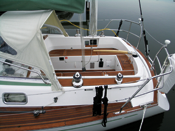 The boat has a handsome teak deck and raised bulwarks topped off with a teak caprail. The caprail is protected around the cleats with stainless steel rub strakes, and the entire outboard length of the rail is covered by a stainless strake making an effective rub rail. The teak decking is installed very nicely and for added flourish the Najad logo is inlaid in the cockpit decking. Najad uses top quality hardware, robustly sized and expertly installed. The overall deck layout is very comfortable and easy to work.
The boat has a handsome teak deck and raised bulwarks topped off with a teak caprail. The caprail is protected around the cleats with stainless steel rub strakes, and the entire outboard length of the rail is covered by a stainless strake making an effective rub rail. The teak decking is installed very nicely and for added flourish the Najad logo is inlaid in the cockpit decking. Najad uses top quality hardware, robustly sized and expertly installed. The overall deck layout is very comfortable and easy to work.
I was pleasantly surprised to see the boat equipped with a tiller-the benefits of wheel steering on a smaller boat are hard to find. The tiller gives a natural, connected feel to the boat. As an added benefit, with the tiller folded up, the cockpit is open and clear for entertaining.
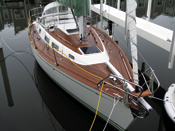 The ergonomics of the cockpit work well. The seatbacks are high for good back support and the well is narrow enough that you can rest your feet on the opposite seat to brace yourself. The reach to the tiller and winches was natural, and loads very manageable. All of the halyards and control lines are conveniently led to the cabinhouse winches and clutches. There is good storage in the lazarettes and in another little compartment placed under the tiller.
The ergonomics of the cockpit work well. The seatbacks are high for good back support and the well is narrow enough that you can rest your feet on the opposite seat to brace yourself. The reach to the tiller and winches was natural, and loads very manageable. All of the halyards and control lines are conveniently led to the cabinhouse winches and clutches. There is good storage in the lazarettes and in another little compartment placed under the tiller.
All Najads have a tempered glass fixed windscreen, and typically a canvas dodger is led off the top edge. The system works very well, visibility is excellent, and the enclosure is watertight. There is a stout handrail on each side of the windscreen to give a secure handhold when going forward. Leland took advantage of this dry space behind the windscreen to mount sailing instruments and a large chartplotter.
The 332 has a fixed point mainsheet that shackles to a padeye on the cockpit sole. This system is convenient at the dock; you can unshackle the block and attach it to the rail, totally clearing the cockpit, but underway it doesn't provide as much sail control as a traveler system. The system is workable since the boat has an easily operated boom vang, but a traveler would have been a nice addition. Unfortunately the layout of the cockpit, dodger and sprayhood made things a little too tight.
The boat has a classic reverse transom, and Najad managed to nestle in a deep swim step without destroying the lines. Two on- deck dorade vents are artfully protected by a custom fabricated stainless steel guard.
The ground tackle is stout, with a stainless anchor roller built into the stem, and powered windlass mounted on the foredeck. The boat has a very large, deck-accessible anchor locker with a teak-laid door. As an added touch, the hull is plated with stainless steel in the area of the anchor to prevent any errant damage.
Down below
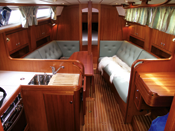 The 332 has a traditional conservative interior that just plain works. The entire cabin is bathed in classic understated Scandinavian elegance and everywhere you look there is buttery smooth satin finished African mahogany. As expected, the joinerwork is very detailed and flawless.
The 332 has a traditional conservative interior that just plain works. The entire cabin is bathed in classic understated Scandinavian elegance and everywhere you look there is buttery smooth satin finished African mahogany. As expected, the joinerwork is very detailed and flawless.
There is a roomy aft cabin on port that extends under the cockpit well, and a very adequate head compartment on starboard. The head is nicely appointed with Corian countertops, a separate hand shower, and an easy-to-clean molded liner. There are opening portlights in both the head and aft cabin.
Just forward of the head is a spacious nav station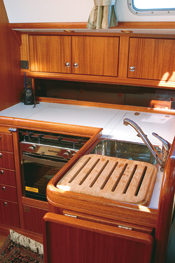 . There is a large blank panel with plenty of room to install electronics. The work surface is large enough for chart work and also an ideal place for a notebook computer. The large electrical panel is well marked and allows room for future expansion. I especially liked the nav light indicators that were placed onto a graphic representation of the boat. It is very handy for seeing just which lights are on or off.
. There is a large blank panel with plenty of room to install electronics. The work surface is large enough for chart work and also an ideal place for a notebook computer. The large electrical panel is well marked and allows room for future expansion. I especially liked the nav light indicators that were placed onto a graphic representation of the boat. It is very handy for seeing just which lights are on or off.
The U-shaped galley is on port, right at the base of the companionway stairs. The galley has plenty of fiddled solid surface counter space, a top-loading refrigeration compartment and a deep double sink. A two-burner gimbaled propane stove rounds things out. Since you can never have too much counter space, Najad added a little flip-up section that extends out from the sink area. There is plenty of storage space, and the cabinets include an ingenious moveable peg system to assure a nice cozy fit for all of your galley ware
The saloon is a classic design with opposing settees and a centerline folded leaf dining table. The long settees will make great sea berths-the seat backs even lift to expose another six to eight inches of shoulder room, something this hearty Midwestern guy was happy to see. The overhead includes a beefy mahogany handrail, and there are several integral handholds throughout. There is storage above each settee in both open compartments and in several enclosed cabinets.
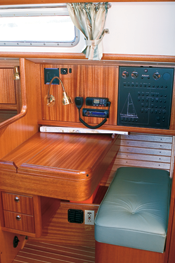
Forward, there is a bright and airy V-berth, with a hanging locker and lots more storage in overhead compartments and under the bunk. This space is nicely lit and ventilated with an opening deck hatch.
Since Najad is located in the higher latitudes, the boats are equipped from the factory with propane forced-air heaters. It was in the forties on the day I sailed and the warm cabin was cozy place to warm up after the sail. There is even a heat port in the cockpit well-with the enclosure erected the cockpit can be brought up to T-shirt temperatures.
Underway
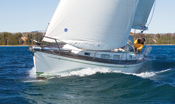 We powered out of Port Washington's inner harbor with the 28-horsepower Volvo Penta diesel. The engine drove the boat easily and the boat was very responsive to the tiller. The engine was quiet and had very little vibration.
We powered out of Port Washington's inner harbor with the 28-horsepower Volvo Penta diesel. The engine drove the boat easily and the boat was very responsive to the tiller. The engine was quiet and had very little vibration.
We raised sails in the stilling basin and sailed out into the lake. The fresh breeze quickly accelerated the boat. The boat's beautiful laminated sails did a great job.
The boat tracked straight and true, and any movement of the tiller was immediately answered. Since we had a picture-perfect day it was tough to assess the sea motion of the boat, but it did nicely handle the steep powerboat wake, powering straight through without pounding. We tacked smartly through the wind, the mass and momentum of the boat helping to keep the speed up through the tack.
The tall carbon fiber rig did the boat proud, even though we didn't need extra sail area in the solid breeze. I just love the feel of a carbon rig. It is tough to explain, but the whole motion of the boat just feels softer and smoother.
Close hauled the boat did a solid 6 to 7 knots in 16 knots apparent, not bad for a heavy cruising boat with a 26-foot, 8-inch waterline. The boat handled the puffs well, putting its shoulder down and accelerating. Cracking off we accelerated and got a magic carpet ride that I could have ridden all the way to the Michigan shoreline. We were a bit shorthanded to try out any kites, but I am sure we could have touched double digits. The boat handled beautifully under all conditions, it was tough to call it a day and turn back to the harbor.
After spending the afternoon sailing the boat, I think Dr. Leland's dream has come true-he has built an offshore capable cruiser with sporty enough performance to still have lots of fun around the buoys. I see both landfalls and silver in his future.

Comments